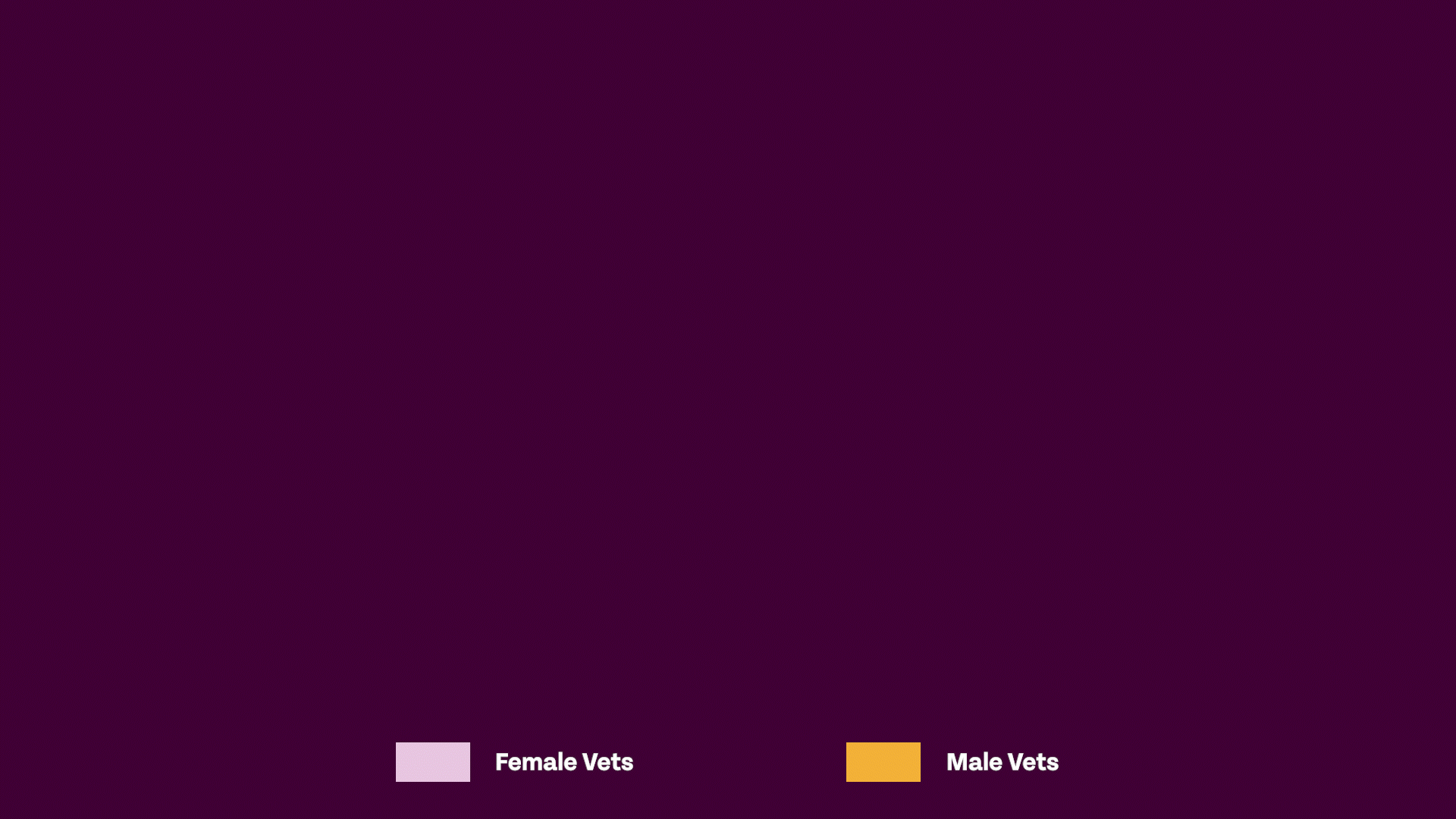The state of women in vet med—according to the data

In honor of Women’s History Month, we’re looking at some of the big picture numbers regarding the state of women (and those who identify as female) in veterinary medicine. Because, while there are more women in veterinary medicine than ever before, it’s important to note that this does not indicate gender equality in the profession.
From the gender pay gap and the “motherhood penalty” to lack of representation in vet school leadership, the data raise questions about systemic bias hindering female advancement and the role of practice ownership in future individual prosperity.
As we examine the profession's shift, we encourage members of the veterinary community to consider these disparities and ask not only how organizations can change, but also where individuals have the power to recognize and take action to correct these inequalities.
The feminization of veterinary medicine
Veterinary medicine has been predominantly female in the US since 2009.1 That trend is continuing, with 87.3% of current veterinary school applicants identifying as female2, as well as 88% of veterinary technicians.3

The changing population of veterinary schools
From 1976 to 1995, the number of males applying to US veterinary colleges decreased by more than half while the number of female applicants nearly doubled.4 More than 80% of the class of 2025 is female2, but the leadership of veterinary schools—including 75% of vet school deans5—largely identify as male.
More males in leadership at all levels can create barriers for female STEM students throughout their academic careers. Llorens et al. (2021) state, “Positions on review panels with the power to hire, promote, approve funding, or decide policy are still largely offered to men, whose own biases (unconscious or otherwise) may impede the advancement of women academics.”6

The academic achievement gap
In academia, female vet med professionals see fewer opportunities to advance as Principal Investigators and have fewer offers for research collaboration than male counterparts.
Morello et al. (2023), point to theories that systemic gender bias in academic institutions and private practices leads to devaluation of “women’s work” resulting in females being denied equal resources and access while the overall status of the profession is diminished. 1
The gender pay gap
Median income has increased for both male and female veterinarians, but the gender gap remains constant. The median income of female veterinarians in private practice grew from $79,000 in 20077 to $100,115 in 2021.8 During the same timeframe, male DVMs’ median income grew from $109,0007 to $132,196. 8
The widening of the salary gap over time
Just out of vet school, the gender gap between male and female DVMs’ starting salaries is only about 3%. However, once in their careers, female specialists in private practice—where income is often based on production—make 25%–29% less than males. In academia, where positions are salaried, female DVMs earn 8%–10% less.
When looking at the top quarter of earners, female veterinarians make an average $100,000 less than males doing the same jobs.9
The motherhood penalty
Despite the fact that women make up half the US labor force—and that about 71% of mothers with children at home are working—mothers earn only 58 cents for every dollar paid to fathers, due to what’s been called the “motherhood penalty.”
Many mothers stay out of the workforce during their prime career-building years to raise children—and once they return, their earnings never catch up to male counterparts.10
The impact of practice ownership
Practice ownership is linked to higher earnings and more career satisfaction. By 2028, females are projected to own more private practices than male individuals for the first time.
Meanwhile, private practice ownership is in rapid decline, with 77% of the market owned by corporations (the majority of which are S-Corporations, meaning they can have up to 100 shareholders).
Consolidators and large group practices such as Banfield, VCA, VetCor, National Veterinary Associates, Southern Veterinary Partners, and Pathway Vet Alliance make up less than 25% of the total number of practices in the US.11

Discussion
As the profession continues to trend female, more research is being done to examine the factors impacting the state of women in vet med. And as private practices become more female-owned, there may be new opportunities to invest in and empower women through entrepreneurship.
Here’s what some others have had to say:
"The devaluation of women's labor may stigmatize occupations with higher proportions of women in them such that jobs performed largely by women pay less than comparable jobs done by men, and men's wages within an occupation are lower the more heavily female-dominated it is."4
—Anne Lincoln, PhD, author of The Shifting Supply of Men and Women to Occupations: Feminization in Veterinary Education.
“To monitor progress towards gender equity within the profession, future work is needed to assess gender representation over different phases of veterinary career tracks, including in student populations.”12
—Zezeau et al. (2024)
“One of the biggest [wage gap factors] is that men own practices more frequently than women do, and practice ownership is a great builder of wealth compared to being an associate or being an employee.” 2
—Samantha Morello, DVM, DACVS (LA)
“It’s important that we start as a profession to think about ways to promote and encourage ownership. One way to do that is to include business management or startup finance classes in our curriculum. Another way is to advocate for government support to new DVM graduates who want to start a new business. It can be similar to the loan repayment program or any other incentives.”11
— Frederic Ouedraogo, PhD
“If you’re going to get around the motherhood penalty, you have to start paying leave benefits for men and women equally. Then, the woman is not inherently penalized for taking that leave.”2
—E. Scott Osborne, President, Through Women’s Eyes
WORKS CITED
1 Gender differences in research collaborations and academic advancement among veterinary medical college faculty (JAVMA)
https://avmajournals.avma.org/view/journals/javma/261/8/javma.23.02.0111.xml
2 The Gender Pay Gap: Why More Women in Vet Med Does Not Equal Gender Equality (Trends)
https://www.aaha.org/publications/trends-magazine/trends-articles/2023/march-2023/f1-gender-pay-gap/
3 DataUSA: Veterinary technologists and technicians
https://datausa.io/profile/soc/veterinary-technologists-and-technicians
4 The Gender Shift (DVM360)
https://www.dvm360.com/view/gender-shift-0
5 Study finds shortage of women in leadership positions (DVM360)
https://www.dvm360.com/view/study-finds-shortage-of-women-in-leadership-positions
6 Gender bias in academia: a lifetime problem that needs solutions (Neuron)
https://www.cell.com/neuron/fulltext/S0896-6273(21)00417-7?
7 History of Women in Veterinary Medicine in the U.S. (Today’s Veterinary Practice)
https://todaysveterinarypractice.com/news/the-history-of-women-in-veterinary-medicine-in-the-u-s/
8 DataUSA
https://datausa.io/profile/soc/veterinarians
9 Pay Equity Toolkit (WVLDI)
https://wvldi.org/wp-content/uploads/2023/07/FINAL_Pay-Equity-Toolkit.pdf
10 The Motherhood Penalty (AAUW)
https://www.aauw.org/issues/equity/motherhood/
11 Women practice owners projected to overtake men within a decade: Corporate ownership spikes while private holdings fall (JAVMA)
https://www.avma.org/javma-news/2020-12-15/women-practice-owners-projected-overtake-men-within-decade
12Characterizing Global Gender Representation in Veterinary Executive Leadership (Journal of Veterinary Medical Education)
https://jvme.utpjournals.press/doi/full/10.3138/jvme-2023-0092?role=tab
Cara Hopkins is AAHA’s Managing Editor
Photo credit: © tomozina E+ via Getty Images Plus
Disclaimer: The views expressed, and topics discussed, in any NEWStat column or article are intended to inform, educate, or entertain, and do not represent an official position by the American Animal Hospital Association (AAHA) or its Board of Directors.
NEWStat Advancements & research Interesting/unusual Practice management




